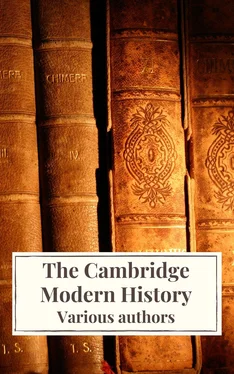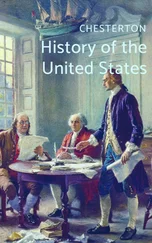R. Nisbet Bain - The Cambridge Modern History
Здесь есть возможность читать онлайн «R. Nisbet Bain - The Cambridge Modern History» — ознакомительный отрывок электронной книги совершенно бесплатно, а после прочтения отрывка купить полную версию. В некоторых случаях можно слушать аудио, скачать через торрент в формате fb2 и присутствует краткое содержание. Жанр: unrecognised, на английском языке. Описание произведения, (предисловие) а так же отзывы посетителей доступны на портале библиотеки ЛибКат.
- Название:The Cambridge Modern History
- Автор:
- Жанр:
- Год:неизвестен
- ISBN:нет данных
- Рейтинг книги:4 / 5. Голосов: 1
-
Избранное:Добавить в избранное
- Отзывы:
-
Ваша оценка:
- 80
- 1
- 2
- 3
- 4
- 5
The Cambridge Modern History: краткое содержание, описание и аннотация
Предлагаем к чтению аннотацию, описание, краткое содержание или предисловие (зависит от того, что написал сам автор книги «The Cambridge Modern History»). Если вы не нашли необходимую информацию о книге — напишите в комментариях, мы постараемся отыскать её.
The first series was planned by Lord Acton and edited by him with Stanley Leathes, Adolphus Ward and George Prothero.
The Cambridge Modern History Collection features all five original volumes:
Volume I: The Renaissance
Volume II: The Reformation, the End of the Middle Ages
Volume III The Wars of Religion
Volume IV: The 30 Years' War
Volume V: The Age of Louis XIV
The Cambridge Modern History — читать онлайн ознакомительный отрывок
Ниже представлен текст книги, разбитый по страницам. Система сохранения места последней прочитанной страницы, позволяет с удобством читать онлайн бесплатно книгу «The Cambridge Modern History», без необходимости каждый раз заново искать на чём Вы остановились. Поставьте закладку, и сможете в любой момент перейти на страницу, на которой закончили чтение.
Интервал:
Закладка:
While inland discovery and the spread of Christianity were thus proceeding concurrently in the North of Europe and Central Asia, a process somewhat similar in principle, but different in its aspect, was going on in the South, where the Mediterranean Sea divided the Christian world from the powerful “Saracens,” or Mohammadans of Northern Africa. The conquests of this people, of mixed race, but united in their fanatical propagation of the neo-Arab religion, had been made when Southern Europe, weak and divided, still bore the marks of the ruin which had befallen the Western Empire. The greater part of Spain had fallen into their hands, and they had invaded, though fruitlessly, France itself. Charles the Great had begun the process of restoring the Christian West to stability and influence, and under his successors Western Christendom recovered its balance. Yet the Saracen peoples still preponderated in maritime power. They long held in check the rising maritime power of Venice and Genoa; they overran Corsica, Sardinia, and the Balearic Islands. Nor was the domination of these vigorous peoples confined to the Mediterranean. In the Red Sea and on the East coast of Africa, frequented by them as far south as Madagascar, they had no rivals. Eastward from the Red Sea they traded to, and in many places settled on, the coasts of India, and the continental shores and islands of the Far East. That branch which held Barbary and Spain was not likely to leave unexplored the Western coast of Africa and the Canary Islands. It was on this coast that the principal work achieved in the Age of Discovery had its beginnings; and although maritime enterprise flourished at Constantinople and Venice, there can be little doubt that these beginnings are due to the Saracens. The Moors, or Saracens of North-west Africa, must have made great progress in ship-building and navigation to have been able to hold the Mediterranean against their Christian rivals. Masters of North Africa, they carried on a large caravan trade across the Sahara with the negro tribes of the Soudan. It is certain that at the beginning of the Age of Discovery they were well acquainted with the dreary and barren Atlantic coast of the Sahara, and knew it to be terminated by the fertile and populous tract watered by the Senegal river; for this tract, marked “Bilad Ghana” or “Land of Wealth,” appears on a map constructed by the Arab geographer Edrisi for Roger II, the Norman King of Sicily, about the year 1150. That they habitually or indeed ever visited it by sea, is improbable, since it was more easily and safely accessible to them by land; and the blank sea-board of the Sahara offered nothing worthy of attention. The Italians and Portuguese, on the contrary, excluded from the African trade by land, saw in Bilad Ghana a country which it was their interest to reach, and which they could only reach by sea. Hence, the important events of the Age of Discovery begin with the coasting of the Atlantic margin of the Sahara-first by the Genoese, in the thirteenth and fourteenth centuries, then by the Portuguese, in the first half of the fifteenth-and with the slave-raiding expeditions of the latter people on the voyage to and in Bilad Ghana itself. The name Ghana became known to the Genoese and Portuguese as “Guinea,” and the negroes who inhabited it-a pure black race, easily distinguishable from the hybrid wanderers, half Berber and half black, of the Western Sahara—were called “Guineos.” Hitherto the Portuguese and Spaniards had purchased blacks from the Moors; by navigating the African coast they hoped to procure them at first hand, and largely by the direct process of kidnapping.
While we know nothing of any voyages made by the Moors to Bilad Ghana, and very little of the expeditions of the Genoese explorers who followed them, we possess tolerably full accounts of the Portuguese voyages from their beginning; and these accounts leave us in no doubt that the nature and object of the earliest series of expeditions were those above indicated. The slave-traders of Barbary, until the capture of Ceuta by the Portuguese in 1415, may have occasionally supplemented their supply of slaves obtained through inland traffic, by voyages to the Canary Islands, made for the purpose of carrying off the Guanche natives. Probably they also frequented the ports and roadsteads on the Barbary coast outside the Straits. But the possession of Ceuta enabled the Portuguese to gain a command of the Atlantic which the Moors were not in a position to contest. Dom Henrique, Iffante of Portugal, and third surviving son of King Joao I, by Philippa of Lancaster, sister of Henry IV, King of England, became Governor of Ceuta, in the capture of which he had taken part, and conceived the plan of forming a “Greater Portugal1” by colonising the Azores and the islands of the Madeira group, all recently discovered, or rediscovered, by the Genoese, and conquering the “wealthy land” which lay beyond the dreary shore of the Sahara. The latter part of this project, commenced by the Iffante about 1426, involved an outlay which required to be compensated by making some pecuniary profit; and with a view to this Dom Henrique subsequently resolved to embark in the slave-trade, the principal commerce carried on by the Moors, over inland routes, with the Soudan and Bilad Ghana. Having given his slave-hunters a preliminary training, by employing them in capturing Guanches in the Canary Islands, he commissioned them in 1434 to pass Cape Bojador and make similar raids on the sea-board of the Sahara. The hardy hybrid wanderers of the desert proved more difficult game than the Guanches. For the purpose of running them down, horses were shipped with the slave-hunters, but the emissaries of the Iffante still failed to secure the intended victims. Vainly, says the chronicler, did they explore the inlet of the Rio do Ouro, and the remoter one of Angra de Cintra “ to see if they could make capture of any man, or hunt down any woman or boy, whereby the desire of their lord might be satisfied.” In default of slaves, they loaded their vessels with the skins and oil of seals. This poor traffic was scarcely worth pursuing, and for several years (1434-41) the project of conquering Bilad Ghana and annexing it to the Portuguese Crown remained in abeyance.
Yet Dom Henrique was not a mere slave-trader. The capture of slaves was destined to subserve a greater purpose-the conversion of Ghana into a Christian dependency of Portugal, to be administered by the military Order of Jesus Christ. In Portugal this Order had succeeded to the property and functions of the dissolved Order of the Temple, and Dom Henrique was its Governor. His project was in substance similar to that carried out by the Teutonic Order in conquering and christianising the heathen Prussians; and the Order of Christ corresponded in its function to the Orders of Santiago and Alcantara, which were actively engaged in ridding Spain of the Moors. Dom Henrique’s scheme represents the final effort of the crusading spirit; and the naval campaigns against the Muslim in the Indian seas, in which it culminated, forty years after Dom Henrique’s death, may be described as the Last Crusade. We shall see that Albuquerque, the great leader of this Crusade, who established the Portuguese dominion in the East on a secure footing, included in his plan the recovery of the holy places of Jerusalem. The same object was avowed by Colombo, who thought he had brought its attainment within measurable distance by the successful voyage in which he had sought to reach the Far East by way of the West.
A curious geographical illusion served as a background and supplement to the scheme. The Senegal river, which fertilises Bilad Ghana, and is the first considerable stream to the southward of the Pillars of Hercules, was believed by Arab geographers to flow from a lake near those in which the Nile originated, and was itself described as the “Western Nile.” The eastern branch of the true Nile flowed through the Christian kingdom of Abyssinia; and if the “ Western Nile” could also be christianised from its mouth to its supposed source-no insuperable task, for Bilad Ghana had not fallen under the sway of Islam- Christian Europe would join hands with Christian East Africa, the flank of the Mohammadan power would be turned, and European adventure would have unmolested access to the Bed Sea and the ports of Arabia, India, and China. How far in this direction the Iffante’s imagination habitually travelled, is uncertain. His immediate object was to subjugate and convert the not yet Islamised heathen in the North-west of Africa, beginning with the Senegal river, and to create here a great Portuguese dependency, the spiritualities of which were, with the consent of the Holy See, to be vested in the Order of Jesus Christ, and were destined to furnish a fund for the aggrandisement of the Order, and the furtherance of its objects.
Читать дальшеИнтервал:
Закладка:
Похожие книги на «The Cambridge Modern History»
Представляем Вашему вниманию похожие книги на «The Cambridge Modern History» списком для выбора. Мы отобрали схожую по названию и смыслу литературу в надежде предоставить читателям больше вариантов отыскать новые, интересные, ещё непрочитанные произведения.
Обсуждение, отзывы о книге «The Cambridge Modern History» и просто собственные мнения читателей. Оставьте ваши комментарии, напишите, что Вы думаете о произведении, его смысле или главных героях. Укажите что конкретно понравилось, а что нет, и почему Вы так считаете.












